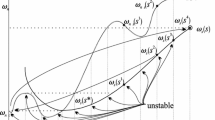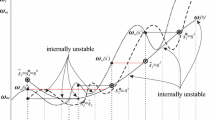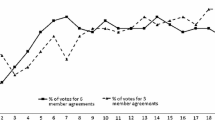Abstract
This paper extends the standard model of self-enforcing dynamic international environmental agreements by allowing the length of the period of commitment of such agreements to vary as a parameter. It analyzes the pattern of behavior of the size of stable coalitions, the stock of pollution, and the emission rate as a function of the length of the period of commitment. It is shown that the length of the period of commitment can have very significant effects on the equilibrium. At the initial date, numerical simulations reveal that as the length of commitment is increased, the potential gain from cooperation tends to diminish, increasing the incentive to ratify the agreements. This suggests that considerable attention should be given to the determination of the length of such international agreements.




Similar content being viewed by others
Notes
Reinganum and Stokey [10] explore the impact of the length of the period of commitment on the optimal extraction of a common pool nonrenewable resource. They find that shrinking the length of the period of commitment leads to a quick depletion of the resource. However, they do not address the issue of coalition formation in their paper.
We could write these conditions with an additional multiplier for the constraint q i ≥0, however, we would get the same outcome.
Notice that: (a) many stable coalitions may exist and (b) a coalition whose size is the greatest integer for which internal stability holds is also externally stable. We therefore consider the largest coalition size for which internal stability is satisfied to be self-enforcing.
Proposition 4 represents a generalization of results in [11], where h=1 necessarily.
These value are obtained from the arithmetic sequence h p =h p−1+0.1; h 0=0.1, p=1,…,2499.
For other values of h<182.6 or h>194.8 used in our simulation, we get similar results.
Notice that the pollution stock is increasing over time interval [0,250] because this interval is included in the first two periods associated to h=183; the illustration covers only the interval [0,250] because of a scale effect. It would not be possible to see the decreasing part of the stock of pollution if Fig. 1 were drawn over a very large interval of time. Nevertheless, the dynamics of the stock of pollution associated with its decreasing part has been provided.
Notice that the interval h<1 represents values of the length of commitment used in our simulation that are lower than one. Those values are: h p =(1+p)/10, p=0,1,2,…,8. Moreover, as p rises, the number of times where an IEA is negotiated over a given interval of time [δ,δ+T] is nonincreasing. Hence, h<1 are values of the length of commitment for which the number of negotiation over a given interval is equal or greater than that associated to h=1.
The simulations are done at t=0 over h for the initial period only. However, since the rates of emission at each period depend only on the stock of pollution and not explicitly on calendar time, the qualitative results are the same for each subsequent period.
References
Barrett S (1994) Self-enforcing international environmental agreements. Oxf Econ Pap 46:878–894
Carraro C, Siniscalco D (1993) Strategies for the international protection of the environment. J Public Econ 52:309–328
D’Aspremont C, Jacquemin A, Gabszewicz JJ, Weymark J (1983) On the stability of collusive price leadership. Can J Econ 16:17–25
de Zeeuw A (2008) Dynamic effects on the stability of international environmental agreements. J Environ Econ Manag 55:163–174
Dockner EJ, Long NV (1993) International pollution control: cooperative versus noncooperative strategies. J Environ Econ Manag 24:13–29
Long NV (1992) Pollution control: a differential game approach. Ann Oper Res 37:283–296
Nkuiya B (2011) International emission strategies under the threat of a sudden jump in damages. Cahiers de recherche CREATE 2011-1, Département d’économique, Université Laval
Nkuiya B, Marrouch W, Bahel E (2011) International environmental agreements under endogenous uncertainty. Working papers e07-32, Virginia Polytechnic Institute and State University, Department of Economics
Pavlova Y (2010) How rapid should emission reduction be? A game-theoretic approach. Nat Resour Model 23:540–564
Reinganum JF, Stokey NL (1985) Oligopoly extraction of a common property natural resource: the importance of the period of commitment in dynamic games. Int Econ Rev 26:161– 173
Rubio SJ, Ulph A (2007) An infinite-horizon model of dynamic membership of international environmental agreements. J Environ Econ Manag 54:296– 310
Rubio SJ, Casino B (2005) Self-enforcing international environmental agreements with a stock of pollutant. Span Econ Rev 7:89– 109
Ulph A (2004) Stable international environmental agreements with a stock pollutant, uncertainty and learning. J Risk Uncertain 29:53–73
Acknowledgements
I am grateful to Gérard Gaudet, Markus Herrmann, Santiago Rubio, and Scott Barrett for their useful comments on earlier drafts of this paper. The paper has also benefited from improvements suggested by anonymous referees.
Author information
Authors and Affiliations
Corresponding author
Appendices
Appendix A: Proof of Condition (7)
Since, by assumption, the q i ,i=1,…,N are time stationary over interval [kh,(k+1)h), so is \(Q=\sum_{i=1}^{N} q_{i}\). Using this result along with (2) and (5), we get

where \(D(Q,z_{k})=-\frac{\gamma}{2}[(\frac{Q}{\rho})^{2}f(r, h)+(z_{k}-\frac{Q}{\rho})^{2}f(r+2\rho, h)+2\frac{Q}{\rho}(z_{k}-\frac{Q}{\rho})f(r+\rho, h)]\) and where f(x,h)=(1−e −hx)/x for all x>0.
Appendix B: The Fully-Cooperative Equilibrium
The value function V N (z)=NV i (z) satisfies the Bellman equation:
where \(Q=\sum_{i}^{N} q_{i}\). The quadratic nature of the benefit function in z suggests the guess: \(V_{i}(z)=-\bar{A}z^{2}/2N-\bar{B}z/N+\bar{C}/N\). Using (11)–(13) for Ψ=V i , n=N and for q i ∈(0,1) we get:
Substituting (28) into the Bellman equation and using the envelope theorem, we obtain
Equating the coefficients of the LHS and RHS of this first-degree polynomial in z, we find that
which is the positive root of the second degree polynomial \(\bar{a}_{2}A^{2}+\bar{a}_{1}A+\bar{a}_{0}=0\), where

Given \(\bar{A}\), we find:
Given \(\bar{A}\) and \(\bar{B}\), using (27) at the optimum, we get \(\bar{C}=N\bar{\beta}[af(r, h)-\bar{B}f(\rho, h)e^{-rh}]/(1-e^{-rh})-N^{2}\bar{\beta}^{2}[N\lambda_{1}+\bar{A}f(\rho, h)^{2}e^{-rh}]/2(1-e^{-rh})\), where \(\bar{\beta}=[af(r, h)-N\bar{B}f(\rho, h)e^{-rh}]/\allowbreak N^{2}[\lambda_{1}+\bar{A}f(\rho, h)^{2}e^{-rh}]\).
The dynamic evolution of the pollution stock is then

The unique solution to the equation x=φ N (x) is
Hence, ∀k=0,1,2,3,… ,
so that
where,
We have 1>R N . Indeed, because all the parameters are nonnegative and \(\bar{A}>0\), we have the following inequality:
Rearranging the terms of this inequality, we get
Dividing the LHS and the RHS of the last inequality by its LHS, we obtain 1>R N . The sequence \(z_{k}-\bar{z}\) defined in (29) being a geometric progression, a necessary and sufficient condition for z k to converge is 1>R N >−1. It has been established that 1>R N . Therefore, if and only if R N >−1, z k converges and its limit is \(\bar{z}\). It converges monotonically if R N >0. The steady-state emission rate exists if and only R N >−1 and is given by
Notice that we have 0<q i (z k )<1. Indeed, let us assume that inequalities from (17) hold. On the one hand, we must have \(af(r, h)< N^{2}[\lambda_{1}+\bar{A}e^{-rh}f(\rho, h)^{2}]+ N\bar{B}f(\rho, h)e^{-rh}\allowbreak +z_{k}N[\lambda_{2}+\bar{A}f(\rho, h)e^{-h(r+\rho)}]\) which, rearranging, yields \(af(r, h)-N\bar{B}f(\rho, h)e^{-rh}-z_{k}N[\lambda_{2}+\bar{A}f(\rho, h)e^{-h(r+\rho)}]<N^{2}[\lambda_{1}+\bar{A}e^{-rh}f(\rho, h)^{2}]\). Dividing the two sides of this inequality by its RHS, one gets q i (z k )<1. On the other hand, it is easy to show that \(af(r, h)-N\bar{B}f(\rho, h)e^{-rh}\geq N[\lambda_{2}+\bar{A}f(\rho, h)e^{-h(r+\rho)}]\bar{z}\). Since from (29) we have \(\bar{z}> z_{2k}\geq 0\), it then follows that \(af(r, h)-N\bar{B}f(\rho, h)e^{-rh}> N[\lambda_{2}+\bar{A}f(\rho, h)e^{-h(r+\rho)}]z_{2k}\). Rearranging this inequality, we can see that the numerator of (28) is positive at the point z 2k . Since the denominator of (28) is always positive, we can conclude that q i (z 2k )>0. Unfortunately, we have not been able to prove analytically that q i (z 2k+1)>0, k=0,1,2,… . However, we take into account this constraint in our simulations.
Appendix C: Proof of Statements in Sect. 4
Making use of (10) and the quadratic approximation \(\varPsi(z)=-\frac{A}{2}z^{2}- Bz + C\), for all z, nonsignatories will emit one at each period if and only if
Notice that, Q≤N; z k ≤N/ρ and f(ρ,h)Q+z k e −ρh≤N/ρ. Replacing Q, z k and f(ρ,h)Q+z k e −ρh by their upper bound in (30) yields
which is condition (19). Thus, if (19) holds, it will be optimal for a nonsignatory to play q j =1 at each period.
Given the quadratic approximation of Ψ, for q j =1, relations (11)–(13) can be rewritten as



Solving (34), we get q i (n,z k )=1 if and only if 1≤n≤n 0(z k )≡af(r,h)/τ(z k ,h).
Pick \(\bar{n}_{1}(z_{k})\) and \(\bar{n}_{2}(z_{k})\) to be the two roots of the second degree equation in n: −n 2[λ 1+Ae −rh f(ρ,h)2]+nτ(z k ,h)=af(r,h). Their expressions are given by (21). Solving (32) yields q i (n,z k )=0 if and only if we have \(\bar{n}_{1}(z_{k})\leq n \leq \bar{n}_{2}(z_{k})\).
Solving (33), we obtain
if and only if \(n\in[\bar{n}_{0}(z_{k}), \bar{n}_{1}(z_{k})]\).
As illustrated in Fig. 5, \(\bar{n}_{1}(z_{k})\) and \(\bar{n}_{2}(z_{k})\) are two positive real numbers but only if there exists n∈(0,N) for which −n 2[λ 1+Ae −rh f(ρ,h)2]+nτ(z k ,h) lies above af(r,h). In addition, \(\bar{n}_{1}(z_{k})< N< \bar{n}_{2}(z_{k})\) is satisfied only when we have the following:
Notice that (i) τ(z,h) is increasing in z; (ii) our simulations show that for z 0 lying below the steady state of the noncooperative equilibrium: N/ρ, the stock of pollution increases over time so that its lower bound is z 0; (iii) z 0<N/ρ, implies that τ(z k ,h)≥τ(z 0,h), k=0,1,2… ; (iv) if we replace z k by z 0 in (36), we will get exactly the condition in (20). Thus, if the condition −N 2[λ 1+Ae −rh f(ρ,h)2]+Nτ(z 0,h)>af(r,h) holds, it will be so for (36). The inequality (20) is then a sufficient condition to have \(\bar{n}_{1}(z_{k})< N< \bar{n}_{2}(z_{k})\), k=0,1,2,… .
Since we have: nτ(z k ,h)≥−n 2[λ 1+Ae −rh f(ρ,h)2]+nτ(z k ,h), when conditions (19)–(20) hold, we also have \(\bar{n}_{0}(z_{k})\leq \bar{n}_{1}(z_{k})\), as illustrated in Fig. 5. Finally, making use of Q≤N; \(z_{k}\leq \tilde{z}\) for all k, we have shown that \(\bar{n}_{0}(z_{k})\geq 1\) when the condition (20) is satisfied.
Summarizing, if conditions (19)–(20) are satisfied, we must have two results. On the one hand, we must have \(1\le\bar{n}_{0}(z_{k})< \bar{n}_{1}(z_{k})< N< \bar{n}_{2}(z_{k})\). On the other hand, nonsignatories must emit one at each period, while the typical signatory’s decision rule for emissions will be given by (23).
Appendix D: The Algorithm
This section presents the algorithm used to approximate the value function Ψ. It is made up of the eight following steps.
-
(i)
Generate values of h, using the formula, h p =h p−1+0.1; p=1,…,2499, with h 0=0.1. We choose plausible parameters a,γ,r,ρ,z 0, and N such that the conditions (16), (17), (19), and (20) always hold for all h p ,p=0,…,2499.
-
(ii)
For each vector (a,γ,r,ρ,z 0,N,h p ) of parameters we consider as initial values for A,B, and C the values of the quadratic value function for the noncooperative equilibrium.
-
(iii)
We generate 251 values of the stocks z in the interval \([z_{0}, \tilde{z}]\) following the sequence: \(z_{p}=z_{0}+p(\tilde{z}-z_{0})/250\); p=0,…,250, where \(\tilde{z}\) represents the steady state of the pollution stock for the noncooperative equilibrium.
-
(iv)
For each value of z from (iii), compute \(\bar{n}_{1}(z)\) and \(\bar{n}_{2}(z)\) using (21), \(\bar{n}_{0}(z)\) using (22), and q i (n,z) using (23). Using (14) and (15), compute Λ(n,z)=V i (n,z)−V j (n−1,z), for Ψ(z)=−Az 2/2−Bz+C.
-
(v)
For each value of z, we calculate n ∗(z), the highest value of n for which Λ(n,z)≥0.
-
(vi)
We then compute for each of the 251 values of z, n ∗(z) and q i (n ∗(z),z). We estimate the relation Q(n ∗(z),z)≈β+αz by linear regression that yields an estimation of (β,α).
-
(vii)
Replacing Q(n ∗(z),z) by β+αz in (18) and equating the coefficient of power of z, we get the new estimation of A, B, and C, which are the following:

-
(viii)
We repeat this operation until convergence is obtained, i.e., variations of A,B, and C not greater than 5 % or the number of iteration not greater than 101.
Rights and permissions
About this article
Cite this article
Nkuiya, B. The Effects of the Length of the Period of Commitment on the Size of Stable International Environmental Agreements. Dyn Games Appl 2, 411–430 (2012). https://doi.org/10.1007/s13235-012-0056-5
Published:
Issue Date:
DOI: https://doi.org/10.1007/s13235-012-0056-5






